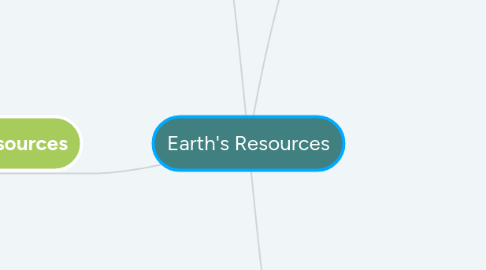
1. III. Water Resources
1.1. a. Distribution of World's Water
1.1.1. i. Total Water --- 100%
1.1.1.1. 1. Oceans --- 97.5%
1.1.1.2. 2. Freshwater --- 2.5%
1.1.1.2.1. Glaciers --- 68.7%
1.1.1.2.2. Groundwater --- 30.1%
1.1.1.2.3. Permafrost --- 0.8%
1.1.1.3. 3. Surface and atmospheric water --- 0.4%
1.1.1.3.1. Freshwater lakes --- 67.4%
1.1.1.3.2. Wetlands --- 8.5%
1.1.1.3.3. Soil moisture --- 12.2%
1.1.1.3.4. Rivers --- 1.6%
1.1.1.3.5. Atmosphere --- 9.5%
1.1.1.3.6. Plants and animals --- 0.8%
2. IV. Soil Resources
2.1. a. Human Activities that leave the soil exposed and speed up erosion
2.1.1. 2. Overgrazing Animals
2.1.1.1. 1. Agricultural Depletion
2.1.2. 3. Deforestation
2.1.3. 4. Mining Operations
2.1.4. 5. Development and Expansion
2.1.5. 6. Recreational activities, like driving vehicles off-road or hiking
2.2. b. Environmental Laws
2.2.1. 1. Republic Act No. 9003
2.2.1.1. i. Regulations
2.2.1.1.1. Littering, throwing, dumping of waste matters in public places
2.2.1.1.2. Undertaking activities in violation of sanitation operation
2.2.1.1.3. Open burning of solid waste
2.2.1.1.4. Causing non-segregated waste
2.2.1.1.5. Squatting in open dumps and landfills
2.2.1.1.6. Open dumping, burying of biodegradable materials in flood-prone areas
2.2.1.1.7. Unauthorized removal of recyclable material
2.2.1.1.8. Mixing of source-separated recyclable material with other solid waste
2.2.1.1.9. Establishment or operation of open-dumps
2.2.1.1.10. Manufacturing, distributing, using, and importing consumer products that are nonenvirnmentally-friendly materials
2.2.1.1.11. Importing toxic wastes misrepresented as 'recyclable' or 'with recyclable content'
2.2.1.1.12. Site preparation, construction, expansion or operation of waste management facilities without an Environmental Compliance Certificate and not conforming with the land use of LGUs
2.2.1.1.13. Construction of establishment within 200 meters from dump sites or sanitary landfills
2.2.1.1.14. Operation of waste disposal facility on any aquifer, groundwater reservoir or wastershed area
3. I. Mineral Resources
3.1. a. Mining and Purification Processes
3.1.1. i. Finding a Deposit
3.1.1.1. 1. Detecting Radiation
3.1.1.2. 2. Measuring Magnetism
3.1.1.3. 3. Variations in Magnetic Field
3.1.1.4. 4. Satellite Photography
3.1.1.5. 5. Geologic Mapping
3.1.2. ii. Establishing a Mine
3.1.3. iii. Mining
3.1.3.1. 1. Surface Mining
3.1.3.1.1. Open-Pit Mining
3.1.3.1.2. Strip Mining
3.1.3.1.3. Mountaintop Mining
3.1.3.1.4. Highwall or Auger Mining
3.1.3.2. 2. Underground Mining
3.1.3.2.1. In-Situ Leach (ISL) Mining
3.1.3.2.2. Heap Leaching
3.1.3.2.3. Brine Mining
3.1.4. iv. The Milling Process
3.1.4.1. 1. Heavy Media Separation
3.1.4.2. 2. Magnetic Separation
3.1.4.3. 3. Flotation
3.1.4.4. 4. Cyanide Heap Leaching
3.2. b. Environmental Impacts of Irresponsible Mining
3.2.1. 1. Erosion
3.2.2. 2. Formation of Sinkholes
3.2.3. 3. Loss of Biodiversity
3.2.4. 4. Contamination of soil, groundwater, and surface water by chemicals
3.3. c. Measure to mitigate/prevent the harmful effects of irresponsible mining
3.3.1. 1. Topsoil replacement using uncontaminated soil
3.3.2. 2. Reintroduction of flora and fauna
3.3.3. 3. Neutralizing acidic water
3.3.4. 4. Backfilling and sealing of abandoned underground mines
3.3.5. 5. Stabilizing the slope of impacted area to reduce erosion
3.4. d. Government and other organizations in the implementation of environmental programs
3.4.1. 1. Mines and Geosciences Bureau (MGB)
3.4.2. 2. Department of Environment and Natural Resources (DENR)
3.4.3. 3. Environmental Management Bureau (EMB)
3.4.4. 4. Philippine Mine Safety and Environment Association (PMSEA)
3.5. e. Environmental Laws
3.5.1. Republic Act 7942
3.5.1.1. Exploration
3.5.1.2. Mineral Processing
3.5.1.3. Mine Wastes and tailings
3.5.1.4. Mineral Resource
3.5.1.5. Mining area
4. II. Energy Resources
4.1. a. Various Energy Sources
4.1.1. i. Non-Renewable Sources
4.1.1.1. 1. Coal
4.1.1.2. 2. Oil
4.1.1.3. 3. Natural Gas
4.1.1.4. 4. Nuclear
4.1.2. ii. Renewable Sources
4.1.2.1. 1. Solar
4.1.2.2. 2. Wind
4.1.2.3. 3. Hydropower
4.1.2.4. 4. Biomass
4.1.2.5. 5. Geothermal
4.2. b. Different Types of Energy
4.2.1. 1. Biomass Energy
4.2.2. 2. Chemical Energy
4.2.3. 3. Electrical Energy
4.2.4. 4. Kinetic Energy
4.2.5. 5. Light Energy
4.2.6. 6. Mechanical Energy
4.2.7. 7. Nuclear Energy
4.2.8. 8. Potential Energy
4.2.9. 9. Sound Energy
4.2.10. 10. Heat Energy
